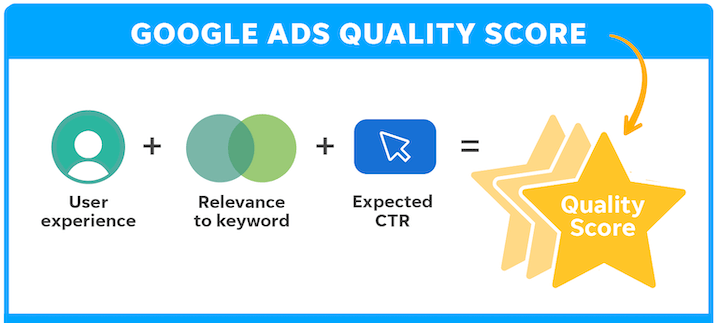Google Ads Quality Score is a metric used by Google to measure the relevance and quality of your ads, keywords, and landing pages. Quality Score is rated on a scale of 1 to 10, with 10 being the highest possible score. The score takes into account a variety of factors, including click-through rate, ad relevance, landing page experience, and other performance indicators
- Google Ads Quality Score is a metric used by Google to measure the relevance and quality of your ads, keywords, and landing pages.
- The higher your Quality Score, the better your ads will perform in terms of visibility, cost-effectiveness, and conversion rates.

Table of Contents
Importance of a high Quality Score
- A high Quality Score can improve your ad ranking, which means your ads will appear higher on the SERP and be seen by more potential customers.
- A higher Quality Score can also lead to lower costs per click (CPC) and a better return on investment (ROI) for your ad spend.
- A high Quality Score is an indicator of the relevance and usefulness of your ads to search engine users, which can help increase clicks, conversions, and revenue.
Brief overview of tips to improve Quality Score quickly
- Conduct keyword research to find relevant keywords for your ads
- Improve ad relevance by making ads more relevant to keywords and landing pages
- Optimize landing pages to improve relevance and user experience
- Increase click-through rate (CTR) through ad copy and targeting
- Improve user experience on landing pages to keep visitors engaged
- Monitor and refine your Google Ads campaign to ensure optimal performance
Conduct Keyword Research

A. Importance of relevant keywords
- Relevant keywords are essential for driving traffic to your website and attracting potential customers.
- Using relevant keywords in your Google Ads campaign can help improve your Quality Score, ad relevance, and ultimately, your ROI.
B. How to identify keywords that match your business goals
- Start by identifying the main products or services you offer and the problems they solve for your customers.
- Use tools like Google Keyword Planner, Google Trends, and other keyword research tools to identify popular search terms related to your products or services.
- Consider using long-tail keywords, which are more specific and targeted than broad keywords, to reach more qualified leads.
C. Tips for finding relevant keywords for your Google Ads campaign
- Use keyword research tools to identify high-volume, low-competition keywords that match your business goals.
- Review competitor ads and keywords to see what is working for them.
- Consider negative keywords to prevent irrelevant traffic from clicking on your ads.
- Regularly review and refine your keyword list to ensure that it remains relevant and effective.
Improve Ad Relevance

A. Importance of having relevant ads
- Relevant ads can improve your Quality Score, increase click-through rates (CTR), and ultimately, drive more conversions.
- Ads that match the user’s search query and intent are more likely to be clicked on, resulting in a higher CTR and lower cost per click (CPC).
B. Tips for making ads more relevant to your keywords and landing pages
Use your keywords in your ad copy
- Incorporate your targeted keywords into your ad headlines, descriptions, and display URLs.
- Use dynamic keyword insertion (DKI) to automatically insert the user’s search query into your ad copy.
Match your ad copy to your landing page
- Ensure that your ad copy and landing page messaging are consistent and relevant to the user’s search query and intent.
- Include relevant keywords and benefits on your landing page that match the ad copy and user’s search query.
Use ad extensions
- Ad extensions like site links, callouts, and reviews can provide additional relevant information to the user and increase ad relevance.
- Use relevant ad extensions that complement your ad copy and landing page.
C. Best practices for ad copywriting
Focus on benefits, not features
- Highlight the benefits of your products or services rather than just listing features.
- Explain how your product or service solves the user’s problem or meets their needs.
Use a strong call-to-action (CTA)
- Use action-oriented language to encourage users to take action.
- Include a clear CTA in your ad copy that aligns with your landing page and business goals.
Use emotional triggers
- Use emotional triggers like FOMO (fear of missing out) or urgency to encourage users to take action.
- Use social proof like customer reviews or ratings to build trust and credibility.











Leave A Comment